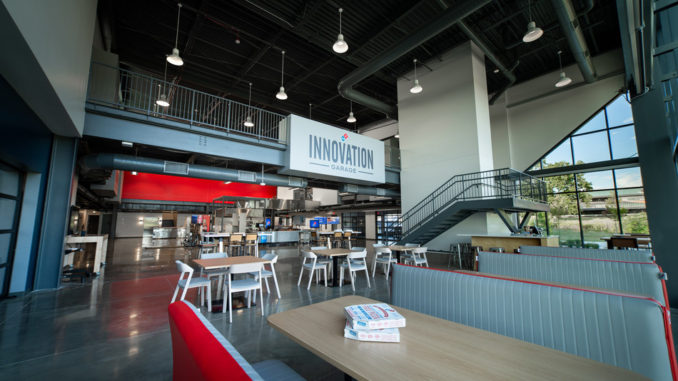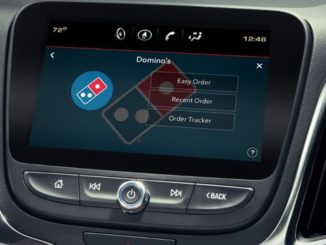
By RTN Staff - 8.22.2019
Emphasis on technology innovation helped Domino’s achieve more than half of all global retail sales in 2018 from digital channels. In the U.S., Domino’s generates over 65% of sales via digital channels and has developed several innovative ordering platforms, including Google Home, Facebook Messenger, Apple Watch, Amazon Echo and Twitter – as well as Domino’s Hotspots, an ordering platform featuring over 200,000 unique, non-traditional delivery locations.
In late 2017, Domino’s began an industry-first test of self-driving vehicle delivery. In June 2019 announced a partnership with Nuro, furthering its exploration and testing of autonomous pizza delivery. And in April 2019, as reported here, the company announced that it is entering the automotive technology realm with the launch of an in-car digital ordering system in partnership with Xevo, a global leader in connected car technology and automotive telematics. Xevo already has in-car commerce technology installed in more than 25 million cars.
Drivers using the AnyWare pizza digital ordering system, as it is known, will be able order Domino’s menu items with just a few taps on their vehicle’s touchscreen device. The Domino’s ordering feature will be automatically loaded on millions of cars with the Xevo platform. The new in-vehicle Domino’s app is powered by Xevo Market.
Much of this and other cutting-edge technology was developed by cross-functional employee teams at its World Resource Center in Ann Arbor, Michigan. As of today, those teams have a new workspace, aptly dubbed Domino’s Innovation Garage. Here they can collaborate on, create, and test new technology-enabled ideas aimed at driving continued growth and performance improvement.

“As a pizza company with a focus on technology, we want our team members to have a workspace that encourages experimentation and fosters an environment to take risks, test innovations and fail-fast so they can bring their best cutting-edge ideas to life for the brand’s customers and stores,” “said Kelly Garcia, Domino’s chief technology officer.
The new 33,000-square-foot, two-story building has an open-concept design space for 150 Domino’s team members, collaboration workspaces, private meeting rooms and a fully-functioning pizza theater. Project-based teams will use the pizza theater, which features the next-generation design, to develop and test new technology, such as ordering kiosks and a carryout tracker, in a store setting. Domino’s Innovation
Garage also has a dedicated space for testing delivery innovations, including the GPS delivery tracking experience, the customer interface on autonomous pizza delivery vehicles and robots such as Nuro’s R2 – an unmanned vehicle that will test pizza deliveries later this year.
In addition to future technology, the facility hold all of Domino’s current AnyWare ordering technology, in-store technology and a quality assurance lab for testing prototypes.
“Having a hub for our community of smart, creative and dynamic team members to develop our brand and take it to the next level is important for our continued success,” said Garcia. “We’re proud to now have a space dedicated to learning, exploring, testing and launching new ideas in a way that only Domino’s can do.”
Founded in 1960, Domino’s Pizza now ranks the largest pizza company in the world based on retail sales, with a significant business in both delivery and carryout pizza. It ranks among the world’s top public restaurant brands with a global enterprise of more than 16,300 stores in over 85 markets. Its system is comprised of independent franchise owners who accounted for 98% of Domino’s stores as of the second quarter of 2019.
The company had global retail sales of over $13.5 billion in 2018, with nearly $6.6 billion in the U.S. and more than $6.9 billion internationally. In the second quarter of 2019, Domino’s had global retail sales of over $3.2 billion, with over $1.6 billion in the U.S. and over $1.6 billion internationally. At suggested, much of the credit for these sales numbers can be attributed to the company’s unwavering focus on continuous technology innovation.



